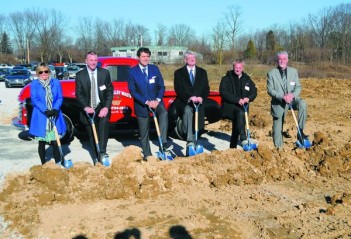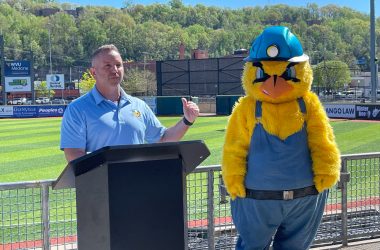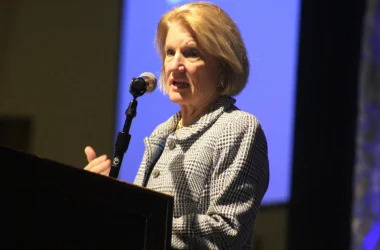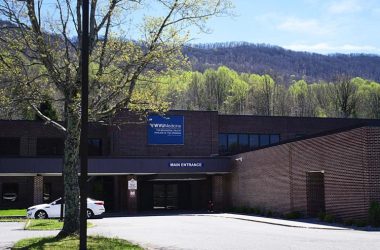
Entsorga West Virginia LLC company officials and local dignitaries held a groundbreaking ceremony Wednesday morning for the $25 million resource recovery plant to be built off Grapevine Road near Martinsburg. From left: Joy Lewis, regional representative for Governor Tomblin; John Decker, Apple Valley Waste president; Pietro Cella Mazzariol, Entsorga chief executive officer; Clint Hogbin, Berkeley County Solid Waste Authority committee chairman; Paolo Carollo, Chemtex vice president; and Doug Copenhaver, Berkeley County Council president.
MARTINSBURG, W.Va. — Approximately 130 people were on hand Wednesday for the Entsorga West Virginia LLC groundbreaking ceremony – an event that celebrated how far the waste-to-solid fuel project has come since its local inception six years ago, while also contemplating where this new technology may go next nationally.
That’s because the $25 million facility is the first resource recovery facility in the United States to use the HEBioT mechanical biological treatment, company officials said.
This system – which is already being used at four European sites, with another one under construction -converts mixed municipal waste to a clean-burning solid recovered fuel that can be used at industrial sites (including cement kilns and steel mills) as a federally approved alternative or supplement to fossil fuels.
Local waste from the Eastern Panhandle – Berkeley, Jefferson, Morgan and Hampshire counties – will be the waste stream that ultimately provides a fuel source for the Essroc cement plant. As a result, an estimated 80 percent of it will no longer be landfilled, said Berkeley County Solid Waste Authority Chairman Clint Hogbin, who emceed the event.
“Today is a very important event impacting the future of solid waste in not only the Eastern Panhandle, but also the entire state of West Virginia. We’re here to celebrate the groundbreaking of the state’s first resource recovery facility, and also the nation’s first to utilize a mechanical biological treatment process,” Hogbin said.
The facility is being built on former Berkeley County landfill property and is expected to be operational in early 2017. Site work is already under way, and construction is expected to begin in this spring or perhaps earlier, depending on the weather.
Facility highlights include an 85,000-square-foot processing plant (which includes a 47,000-cubic-foot biofilter), a ferrous and nonferrous metal seperation/recycling operation and an office area. There will also be a drop-off area for public use, he said.
One very special feature will be a 650-square-foot educational facility, named for long-time SWA member Edgar J. Mason – an annoucement later in the program that drew a standing ovation from audience members.
“All of this will operate here on 12 acres of land leased to Entsorga for up to 30 years,” Hogbin said.
Emily Dyson, who has worked on the project since the beginning, said there is no employee interaction – from the time it is delivered through being transformed into solid recovered fuel – with the waste because the facility is mechanized and run by software.
It is a 14-day process from the time the waste gets dumped into the reception pit until it goes out as a solid recovered fuel, said Dyson, who is Entsorga’s director of environment, safety and health.
“During that time, there is a natural organic breakdown of materials. We take those organic materials and give them a prime environment to live in – between the temperature, right air circulation and humidity. And because of that, it can break down the organics. Toward the end of the process we add in the paper goods to give it a kind of solidification – it’s like fluffy, fiberous crunched-up paper,” she said. This will be used in conjunction with coal in the production of Portland cement, Dyson said.
“And that is what will be introduced into the kilns at Essroc, where it will basically get blown into the system after it has been trucked there from here,” Dyson said.
Citing the “visionary” support supplied by Hogbin and other BCSWA members, Entsorga director and officer Frank Celli said he believes the Grapevine Road location was meant to be – and possibly even preordained.
Speaking after the ceremony, which attracted elected officials, interested citizens and about two dozen St. Joseph School second-grade students, Celli said this successful experience will be helpful in choosing other potential sites.
“I honestly think the stars were aligned in this particular case. We obviously can’t say enough about Clint and other Solid Waste Authority members, but even that is significant because it turns out they were proactively looking for a solution to their solid waste needs when Entsorga had first begun speaking to them,” he said, still vividly able to recall when he and John Decker of Apple Valley Waste had been part of those early discussions about providing a feedstock.
However, neither he nor Decker were interested in only providing a wastestream for the proposed facility, Celli said. “We thought there was a much bigger relationship here, and that this could a way to pave the way for how waste is dealt with in the United States,” he said.
It worked locally because Apple Valley had a wastestream supply, Entsorga had the needed technology and Essroc was an outlet for the fuel, he said.
“Call it God, call it fate or whatever you want – I truly believe this facility was meant to be in Martinsburg,” Celli said, adding that a coporate team is already scouting additonal sites across the country.
The Mauck family – including Margaret and Lamar, who attended the ceremony along with daughter Ann and son Tyler who is a student at St. Joseph – couldn’t have agreed more and felt it was important to learn more about this new facility.
“What’s a landfill?” Tyler said, waiting for his mother to replay.
Smiling at his question, Margaret said she hopes one day landfills won’t be needed.
“We really think this is something that’s going to be happening in other parts of the country soon, and we wanted him to know about it. So we were glad that his class was invited to attend, because we want him to be aware of what’s going on,” she said.
Entsorga West Virginia is a joint venture between Apple Valley Waste Technologies LLC, Entsorga USA and Chemtex International Inc. The project is being financed with $25 million in tax exempt, private activity bonds issued by the West Virginia Economic Development Authority.
Staff writer Jenni Vincent can be reached at 304-263-8931, ext. 131, or www.twitter.com/jennivincentwv.






